The expression pattern of matrix-producing tumor stroma is of prognostic importance in breast cancer
- PMID: 27809802
- PMCID: PMC5095990
- DOI: 10.1186/s12885-016-2864-2
The expression pattern of matrix-producing tumor stroma is of prognostic importance in breast cancer
Abstract
Background: There are several indications that the composition of the tumor stroma can contribute to the malignancy of a tumor. Here we utilized expression data sets to identify metagenes that may serve as surrogate marker for the extent of matrix production and vascularization of a tumor and to characterize prognostic molecular components of the stroma.
Methods: TCGA data sets from six cancer forms, two breast cancer microarray sets and one mRNA data set of xenografted tumors were downloaded. Using the mean correlation as distance measure compact clusters with genes representing extracellular matrix production (ECM metagene) and vascularization (endothelial metagene) were defined. Explorative Cox modeling was used to identify prognostic stromal gene sets.
Results: Clustering of stromal genes in six cancer data sets resulted in metagenes, each containing three genes, representing matrix production and vascularization. The ECM metagene was associated with poor prognosis in renal clear cell carcinoma and in lung adenocarcinoma but not in other cancers investigated. Explorative Cox modeling using gene pairs identified gene sets that in multivariate models were prognostic in breast cancer. This was validated in two microarray sets. Two notable genes are TCF4 and P4HA3 which were included in the sets associated with positive and negative prognosis, respectively. Data from laser-microdissected tumors, a xenografted tumor data set and from correlation analyses demonstrate the stroma specificity of the genes.
Conclusions: It is possible to construct ECM and endothelial metagenes common for several cancer forms. The molecular composition of matrix-producing cells, rather than the extent of matrix production seem to be important for breast cancer prognosis.
Keywords: Breast cancer; ECM metagenes; Endothelial metagenes; P4HA3; TCF4; Tumor stroma.
Figures
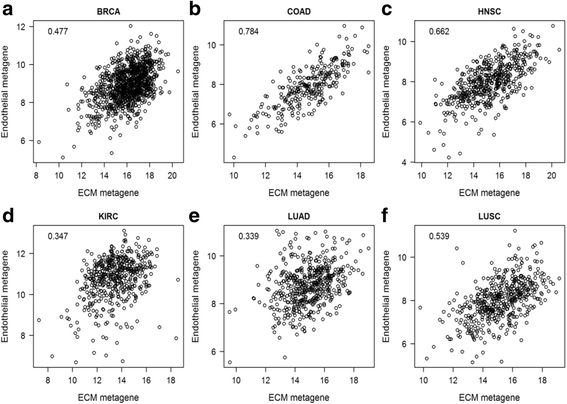
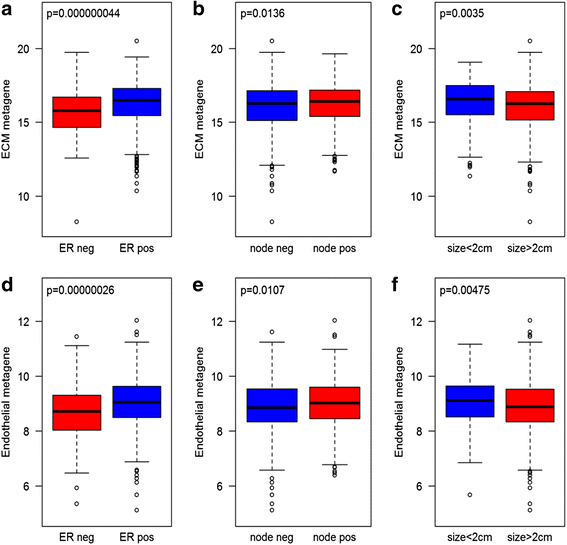
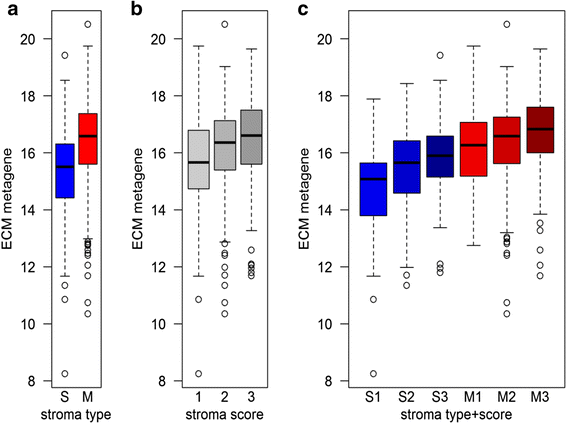
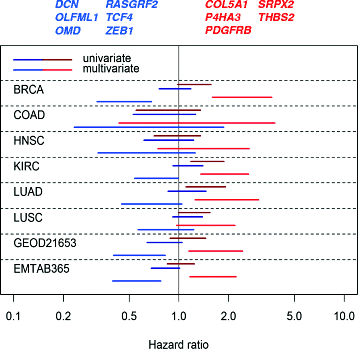
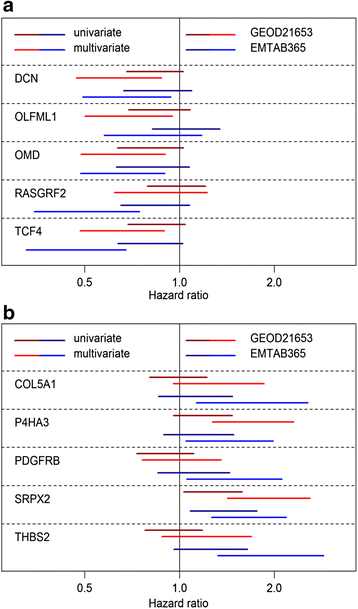
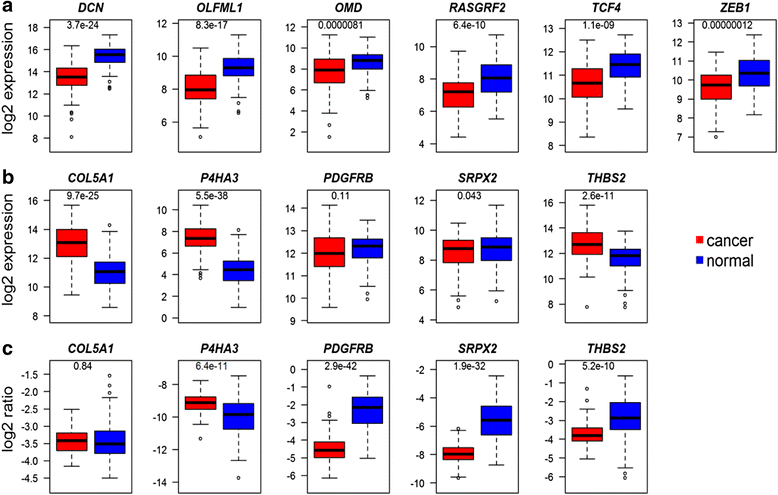
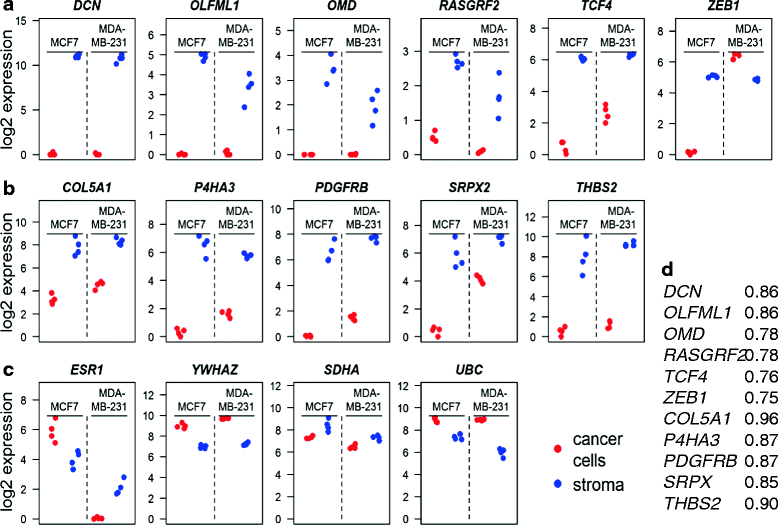
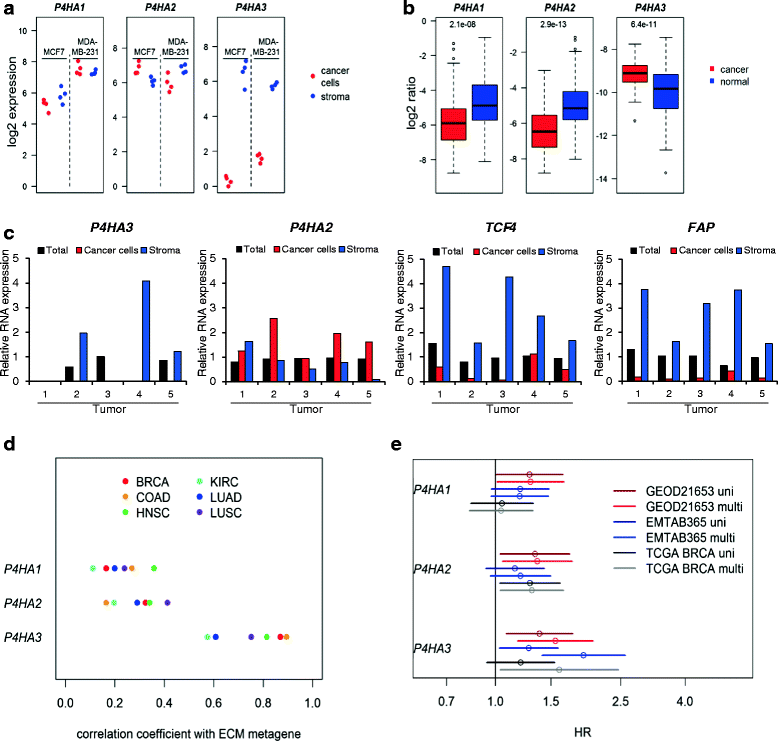
Similar articles
-
Prognostic stromal gene signatures in breast cancer.Breast Cancer Res. 2015 Feb 21;17(1):23. doi: 10.1186/s13058-015-0530-2. Breast Cancer Res. 2015. PMID: 25848820 Free PMC article.
-
Molecular anatomy of breast cancer stroma and its prognostic value in estrogen receptor-positive and -negative cancers.J Clin Oncol. 2010 Oct 1;28(28):4316-23. doi: 10.1200/JCO.2009.27.2419. Epub 2010 Aug 30. J Clin Oncol. 2010. PMID: 20805453
-
Neoplastic and stromal cells contribute to an extracellular matrix gene expression profile defining a breast cancer subtype likely to progress.PLoS One. 2013;8(2):e56761. doi: 10.1371/journal.pone.0056761. Epub 2013 Feb 18. PLoS One. 2013. PMID: 23441215 Free PMC article.
-
Why the stroma matters in breast cancer: insights into breast cancer patient outcomes through the examination of stromal biomarkers.Cell Adh Migr. 2012 May-Jun;6(3):249-60. doi: 10.4161/cam.20567. Epub 2012 May 1. Cell Adh Migr. 2012. PMID: 22568982 Free PMC article. Review.
-
Tumor stroma derived biomarkers in cancer.Cancer Metastasis Rev. 2009 Jun;28(1-2):177-83. doi: 10.1007/s10555-008-9175-2. Cancer Metastasis Rev. 2009. PMID: 19259624 Free PMC article. Review.
Cited by
-
Development of an Immune-Related Prognostic Index Associated With Glioblastoma.Front Neurol. 2021 May 19;12:610797. doi: 10.3389/fneur.2021.610797. eCollection 2021. Front Neurol. 2021. PMID: 34093386 Free PMC article.
-
COL6A6 interacted with P4HA3 to suppress the growth and metastasis of pituitary adenoma via blocking PI3K-Akt pathway.Aging (Albany NY). 2019 Oct 17;11(20):8845-8859. doi: 10.18632/aging.102300. Epub 2019 Oct 17. Aging (Albany NY). 2019. PMID: 31627190 Free PMC article.
-
Functional characterization of TSPAN7 as a novel indicator for immunotherapy in glioma.Front Immunol. 2023 Feb 9;14:1105489. doi: 10.3389/fimmu.2023.1105489. eCollection 2023. Front Immunol. 2023. PMID: 36845098 Free PMC article.
-
Gene Expression Profiling in Early Breast Cancer-Patient Stratification Based on Molecular and Tumor Microenvironment Features.Biomedicines. 2022 Jan 24;10(2):248. doi: 10.3390/biomedicines10020248. Biomedicines. 2022. PMID: 35203458 Free PMC article. Review.
-
Characterization of the Biomechanical Properties of Skin Using Vibrational Optical Coherence Tomography: Do Changes in the Biomechanical Properties of Skin Stroma Reflect Structural Changes in the Extracellular Matrix of Cancerous Lesions?Biomolecules. 2021 Nov 17;11(11):1712. doi: 10.3390/biom11111712. Biomolecules. 2021. PMID: 34827711 Free PMC article.
References
Publication types
MeSH terms
LinkOut - more resources
Full Text Sources
Other Literature Sources
Medical

